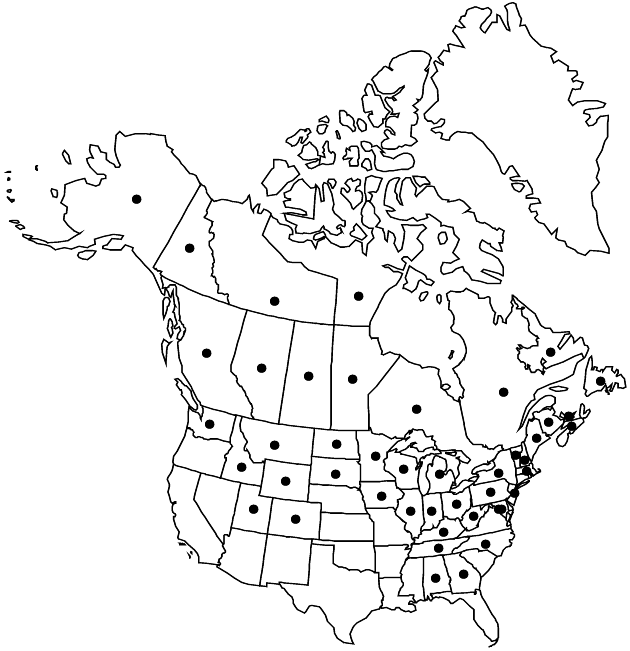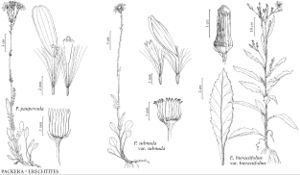Packera paupercula
Bot. Not. 128: 520. 1976.
Perennials, 20–45+ cm; subrhizomatous (bases weakly branched, ascending to erect). Stems 1 or 2–4, loosely clustered, glabrous or sparsely tomentose proximally. Basal leaves petiolate; blades lanceolate to narrowly elliptic or oblanceolate, 30–60+ × 10–20+ mm, bases tapering, sometimes obtuse, margins subentire to dentate or serrate. Cauline leaves gradually reduced (proximals petiolate, sublyrate; mids sessile, not clasping, lanceolate, dissected, incised, or lacerate; distals sessile, bractlike). Heads 2–10+ in loose or compact, corymbiform arrays. Peduncles usually bracteate, sometimes ebracteate, glabrous. Calyculi inconspicuous. Phyllaries 13 or 21, green, 5–8+ mm, glabrous. Ray-florets 0, 8, or 13; corolla laminae (pale-yellow) 5–10+ mm. Disc-florets 50–65+; corolla-tubes 2–3 mm, limbs 2–3 mm. Cypselae 1–2 mm, usually glabrous, sometimes hispidulous on ribs; pappi 3.5–4.5 mm. 2n = 44, 46, 92.
Phenology: Flowering May–late Jun (south), late Jun–early Aug (north).
Habitat: Wet meadows, open woodlands, along streams, rocky outcrops
Elevation: 0–3000 m
Distribution

Alta., B.C., Man., N.B., Nfld. and Labr., N.W.T., N.S., Nunavut, Ont., P.E.I., Que., Sask., Yukon, Ala., Alaska, Colo., D.C., Ga., Idaho, Ill., Ind., Iowa, Ky., Maine, Md., Mass., Mich., Minn., Mont., N.H., N.J., N.Y., N.C., N.Dak., Ohio, Pa., S.Dak., Tenn., Utah, Vt., Wash., W.Va., Wis., Wyo.
Discussion
Ecologically and morphologically, Packera paupercula is the most variable species of the genus in North America. Some “phases” have been treated as separate species, subspecies, varieties, forms, and races. Variation within P. paupercula hints at some interesting evolutionary relationships; characteristics used to separate taxa overlap. Much of the morphologic variation in this species may be due to hybridization and introgression. I do not recognize any of the infraspecific taxa that have been proposed.
Selected References
None.
